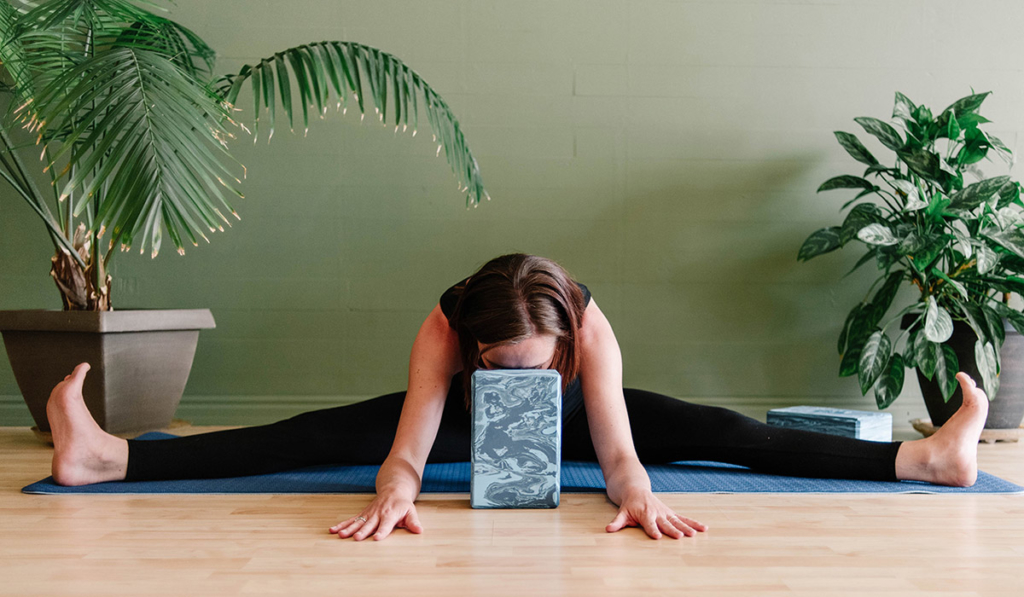
Most of my students have been attending my classes for many years—some for decades. When a newbie comes to class, they often remark that their fellow students, the long-timers, are so mellow and uncompetitive. Everyone’s just doing her own practice at her own pace, and using lots of yoga props.
If a longtime student opts to lie down in a Restorative pose in lieu of a backbend or standing series, I support that. I trust that they’re body-aware enough to know what’s best for them. If a longtime student who once practiced the full version of a pose instead practices a less intense version, I support that too. The ability to tune in and listen to your body—and to follow its instructions—indicates a mature yoga practice. You could even call it “advanced.”
But wait! Aren’t the students who can bust a Titibasana or Eka Pada Raja Kapotasana on command the most righteous yogis? Not necessarily. It’s quite possible that a person whose body will do these poses does have a profound practice. On the other hand, it might be that these flexy folks were born with structures that are capable of such feats. Maybe there’s really nothing “yogic” about it.
Advanced Yoga in the Yoga Sutras
Most people are familiar with the first sutra that describes asana (2.46): “The physical posture should be steady and comfortable.” (Alistair Shearer’s translation). The second of the three sutras on asana (2.47) is not as familiar: “It is mastered when all effort is relaxed and the mind is absorbed in the Infinite.” (Alistair Shearer)
So, asana is mastered when all effort is relaxed? That seems to go against the popular grain. We usually think of asana mastery as being able to do “fancy” poses.
If asana is a method for bringing us to the state of Yoga, none of these things matter. Perhaps all effort can be relaxed when we’ve worn ourselves out through intense practice. Or perhaps we can develop a deep enough awareness to know exactly how to monitor our effort in a given pose on a given day. Maybe then the state of Yoga (the settling of the mind into silence) can permeate each moment of every asana.
How Yoga Props Can Help Us Achieve Mastery
So in order to understand advanced yoga in the context of yoga, we must shift our perspective. The point of yoga practice is not the same as the point of most Western physical practices. We’re not “in it to win it.”
One way is through understanding what using props really means, and what it doesn’t. B.K.S. Iyengar invented yoga props, including yoga blocks, yoga straps, yoga sandbags and yoga bolsters, to allow students of varying levels of strength and flexibility benefit from poses their bodies couldn’t normally practice with integrity. At the grossest level, props help people avoid injury from overstretching or misalignment. At subtler levels, props allow our bodies to achieve alignment continuity, so that our breath can be free, and our bodies can form shapes that allow for the free flow of energy through the nadis.
When I studied with Iyengar, he stated that the purpose of asana is to create a relaxed, balanced environment for the mind—to be absorbed in the Infinite. If props help us achieve the structural integrity that allows for the free flow of breath and prana, then at times advanced yoga practice might actually require that we use props.
Convincing Students to Use Yoga Props
When you’re teaching a class, it may be easier said than done to get students to understand this. Most students see advanced yoga as being able to do the poses without yoga props. Many see yoga props as crutches. This could not be farther from the truth.
Most of my students understand this now. A few folks still resolutely refuse to place a block under their hands in Trikonasana (Triangle Pose). They’re okay with their torsos collapsing in the effort to place their hand on the floor. Sometimes I give them a yoga block, suggesting they try it as an option and tune into how that feels. Sometimes I let them do their pose the way they want to. It’s their practice, after all.
Balancing Safety with Freedom of Expression
As a teacher, my first responsibility is to create a safe space for practice. This means that I need to welcome, respect and celebrate the infinite variety that individuals bring to practice. Teaching them about yoga props, not only for physical safety, but to increase their enjoyment of the practice, is part of this. One of the greatest gifts I feel I can impart is to help them dismantle cultural beliefs about what “advanced” yoga is and is not, or that there is even such a thing as advanced yoga.
How do you encourage students to use yoga props if they need them? How do you walk the fine line between keeping students safe and allowing them to express their asanas the way they want to?
By: Charlotte Bell
Title: Yoga Props and “Advanced Yoga”
Sourced From: www.huggermugger.com/blog/2021/yoga-props-advanced-yoga/
Published Date: Thu, 20 May 2021 21:59:29 +0000
